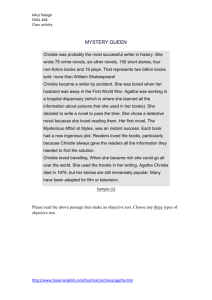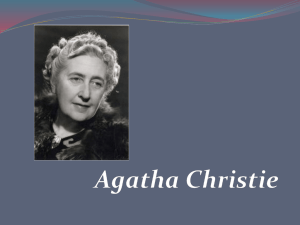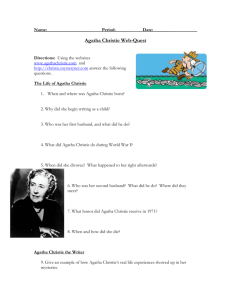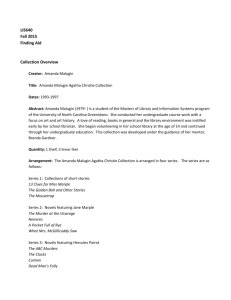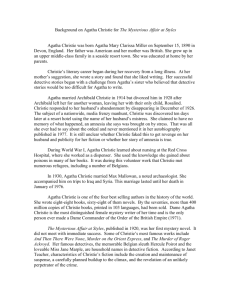Who Done It? - Yorba Linda Public Library
advertisement
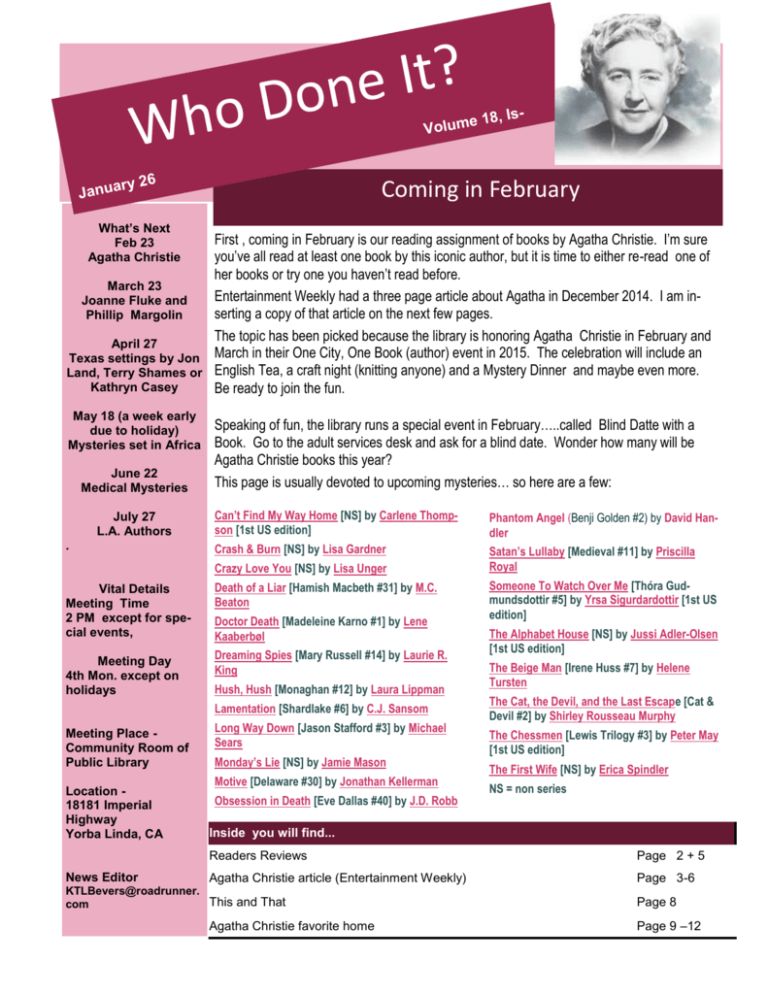
? t I e n o D o Wh r y 26 e 18, Is Volum - Coming in February Janua What’s Next Feb 23 Agatha Christie First , coming in February is our reading assignment of books by Agatha Christie. I’m sure you’ve all read at least one book by this iconic author, but it is time to either re-read one of her books or try one you haven’t read before. March 23 Entertainment Weekly had a three page article about Agatha in December 2014. I am inJoanne Fluke and serting a copy of that article on the next few pages. Phillip Margolin The topic has been picked because the library is honoring Agatha Christie in February and April 27 Texas settings by Jon March in their One City, One Book (author) event in 2015. The celebration will include an Land, Terry Shames or English Tea, a craft night (knitting anyone) and a Mystery Dinner and maybe even more. Kathryn Casey Be ready to join the fun. May 18 (a week early due to holiday) Mysteries set in Africa June 22 Medical Mysteries July 27 L.A. Authors . Speaking of fun, the library runs a special event in February…..called Blind Datte with a Book. Go to the adult services desk and ask for a blind date. Wonder how many will be Agatha Christie books this year? This page is usually devoted to upcoming mysteries… so here are a few: Can’t Find My Way Home [NS] by Carlene Thompson [1st US edition] Phantom Angel (Benji Golden #2) by David Handler Crash & Burn [NS] by Lisa Gardner Satan’s Lullaby [Medieval #11] by Priscilla Royal Crazy Love You [NS] by Lisa Unger Vital Details Meeting Time 2 PM except for special events, Death of a Liar [Hamish Macbeth #31] by M.C. Beaton Meeting Day 4th Mon. except on holidays Dreaming Spies [Mary Russell #14] by Laurie R. King Doctor Death [Madeleine Karno #1] by Lene Kaaberbøl Hush, Hush [Monaghan #12] by Laura Lippman Lamentation [Shardlake #6] by C.J. Sansom Meeting Place Community Room of Public Library Location 18181 Imperial Highway Yorba Linda, CA News Editor Long Way Down [Jason Stafford #3] by Michael Sears Monday’s Lie [NS] by Jamie Mason Motive [Delaware #30] by Jonathan Kellerman Obsession in Death [Eve Dallas #40] by J.D. Robb Someone To Watch Over Me [Thóra Gudmundsdottir #5] by Yrsa Sigurdardottir [1st US edition] The Alphabet House [NS] by Jussi Adler-Olsen [1st US edition] The Beige Man [Irene Huss #7] by Helene Tursten The Cat, the Devil, and the Last Escape [Cat & Devil #2] by Shirley Rousseau Murphy The Chessmen [Lewis Trilogy #3] by Peter May [1st US edition] The First Wife [NS] by Erica Spindler NS = non series Inside you will find... Readers Reviews Page 2 + 5 Agatha Christie article (Entertainment Weekly) Page 3-6 KTLBevers@roadrunner. This and That com Agatha Christie favorite home Page 8 Page 9 –12 Member Reviews Yvonne Stevens, Taylor – THE DOLL – 3.0 The underground world of women and girls as merchandise with a shadowy figure known as “The Doll Maker.” The heroine Vanessa Michael Monroe uses her unique set of skills to overcome her nemesis and deliver her band of justice. The heoine as a bit too unreal. Creepy thriller. Cash, Wiley – THEDARK ROAD TO MERCY - 4.0 Easter and Ruby, endangered little sisters in foster care, are stolen by a wayward father, Wade, an ex-minor league baseball player, who is being chased by an enemy determined to see him pay for his sins. Soulful story, captivating and heartbreaking with a testament of unbreakable bonds of family. Laura Marwood, Alex - THE WICKED GIRLS -3.0 : Reviewed 5/14 Krueger, William Kent - ORDINARY GRACE - 5,0 : Reviewed 11/14. Penny, Louise HOW THE LIGHT GETS IN (Inspector Gamache #9) - 4.5 As I was reading the first chapter I knew this was going to be an awesome book! It is so well written. It is a complex story going back and forth between two mysteries which the author does well making them both suspenseful. There is a psychological intensity throughout the book. The characters are very well drawn. Inspector Gamache is extremely likeable. He is reasonable, courteous and kind. I absolutely loved the ending. The two of the themes running through the story are bitterness and hope. “Ring the bells that still can ring, Forget your perfect offering, There is a crack in everything That’s how the light gets in.” Morrell, David - MURDER AS A FINE ART - 4.5 This is a really intriguing and engrossing historical mystery taking place in 1854 London. It is very atmospheric of the time giving one a look into how it was like to live back then in England. The historical facts don’t take away from the mystery or suspense but rather add to it. I loved the independence of the main female character and how it added to the description of the times back then. There is a bit of humor throughout. It kept me turning the pages! In the book they define “passing on” as “joined the majority”. Parrish, P.J. - HEART OF ICE (Louis Kincaid #11 or 12) - 3,75 I really enjoyed this book. Taking place on Mackinac Island in Michigan, this is about a cold case murder and you really do wonder how on earth the mystery is going to be solved. It has many twists and turns as it proceeds towards the end. You learn about all the characters involved and come to understand and like Chief of Police Kincaid and the State Detective Norm Rafsky as you watch their friendship heal. Stevens, Taylor - THE DOLL (Vanessa Michael Munroe #3) - 3.0 Started out boring and I thought maybe I’d quit reading it but then about 1/3rd the way through it picked up speed making it an okay read though the plot line was weak and not compelling and the ending wasn’t satisfying. Not sure why it got such great reviews or why it won an award. McMahon, Jennifer - THE ONE I LEFT BEHIND - 2.75 It wasn’t much of a thriller and wasn’t suspenseful even though I think it was meant to be. The writing was simplistic. The pace was slow and half way through it got boring. There wasn’t much character development and their secrets weren’t too exciting. It didn’t have much of a surprise ending. Zouroudi, Anner - THE TAINT OF MIDAS (#3) - 3.75 This well written book weaves the Greek myths into the mystery as it points out how present times have changed both in the landscape and how life is lived on the Greek Islands over the years. It is very atmospheric with descriptions of the roads, houses and landscape. It is atmospheric also in how different senses, such as smell, recall memories. The detective, “The Fat Man”, is very kind, philosophical, gentle, thoughtful and fair with his own unorthodox method of fairness. Zouroudi’s books always have very different and interesting ways of dealing out justice. This book focuses on the deadly sin of greed. Nancy Krueger, William Kent - ORDINARY GRACE I loved this book and went on to read several books in his series. Penny, Louise - THE LONG WAY HOME: This was definitely more of a character study of Peter Morrow, a missing friend. I felt it dragged at times. Not my favorite in the series. Tart, Donna - THE GOLDFINCH (winner of the Pulitzer Prize for Literature) Not a mystery, but a very good read. It was referred to as a modern version of Oliver Twist. Glad I ordered it for my Kindle. I kept reading to learn the ending not realizing that the book is 755 pages long! Cash, Wiley - THIS DARK ROAD TO MERCY - 3.75 12 year old Easter and her younger sister are put in a foster home when their mother dies of an overdose. Their father, who had given up his legal rights to the girls, finds them and kidnaps them. There is a pursuit by the girls’ social worker who wants to find the girls and a thug who wants to find the father as the father is suspected of a multimillion-dollar theft. It is a well written easy to read book. The story line holds your interest. The characters are well drawn as the chapters alternate between Easter, the social worker and the gangster. Wonderful dedication: “for families of all kinds”. Todd, Charles - A QUESTION OF HONOR This was my least favorite of the 6 books I read. Amateur sleuth, Bess Crawford, is a nurse serving in Europe during WWI. She is looking back into a murder that took place during her childhood in India. Continued on page 6 2 Agatha Christie 3 4 5 Member reviews cont. (Continued from page 2) story that should have been more entertaining than it was. Parks, Brad - THE GOOD COP by Brad Parks Newspaper reporter, Carter Ross, looks into the suspicious suicide of a New Jersey cop. A fast moving thriller that includes a good sense of humor a la Janet Evanowich. Susan Terry Shames – A KILLING AT COTTON HILL Louise Penny – HOW THE LIGHT GETS IN Shames, Terry - A KILLING AT COTTON HILL Retired sheriff, Samuel Craddock, feels compelled to investigate the murder of his old friend Dora Lee Parjeter. This book takes place in a small town in Texas and will remind readers of Walt Longmire. An enjoyable read. Joan McPherson, Catriona – DANDY GILVER AND A BOTHERSOME NUMBER OF CORPSES Three tries and out..DNF Coyle, Matt – YESTERDAY’S ECHO (2013) – 3.5 Rick Cahill was accused of his wife;’s murder, but was not found guilty. He is now in San Diego and finds himself mixed up with a reporter whose wife has been murdered. Once again Rick is accused. Karen Taylor Stevens – THE DOLL 5.0 Lachlan, Smith – DEAR IS BROKEN = DNF Terry Shames – A KILLING AT COTTON HILL 4.9 Parks, Brad – THE GOOD COP – 3.75 Carter Ross, a reporter, is investigating the dearth of Darius Kipp, a Newark police officer. The cop’s wife cannot her husband would commit suicide. Her pastor gets involved in the investigation. When Kipp’s partner commits suicide Carter is in deeper than is safe for him.—Corruption is involved. Hank Phillippi Ryan – THE WRONG GIRL – 2.75 A death by a foster parent, abandoned children, an adoption agency hands our incorrect pairings when reunions are sought A reporter and a cop seek answers. . Louise Penny – HOW THE LIGHT GETS IN 5.0 McPherson, Catriona – DANNY GILVER AND A BOTHERSOME NUMBER OF CORPSES Wm Kent Krueger, ORDINARY GRACE – 5.0 Wiley Cash – THE DARK ROAD TO MERCY – 3..5 Two girls, whose mother has died, adjust to a group home when their father takes them on a trip. The case worker follows them to baseball game.. Girls come to realize their father really does care for them. Too many viewpoints to be engaging. Chitra Connelly, Michael - THE BURNING ROOM - 2014 - Harry Bosch & Lucia Soto - 4.0 Ng, Celeste EVERYTHING I NEVER TOLD YOU - 2014 3.0 Koenig, Minerva – NINE DAYS – 2014- #1 – 3.75 Set in Texas small town, WitSec female whose handler (town police chief) is killed gets involved with locals efforts to solve various puzzlements. Took too long to read…thus a lower score than it deserves. Kerr, Philip - IF THE DEAD RISE NOT - 2010 – 3.0 A Bernie Gunther Novel Erskine, Kathryn – MOCKINGBIRD -2010 – 4.0 Juv.. book Young girl with Asperger’s syndrome learns to find closure over her brother’s death.(at a school shooting) .as well as helping her father find closure too. Gawande, Atul. - BEING MORTAL: MEDICINE AND WHAT MATTERS IN THE END - 2014 – 4.0 Pinker, Steven - THE SENSE OF STYLE: THE THINKING PERSON'S GUIDE TO WRITING IN THE 21ST CENTURY – 2014 – 2.5 Symmes, Patrick - THE BOYS FROM DOLORES: FIDEL CASTRO'S CLASSMATES FROM REVOLUTION TO EXILE – 2007 – 3.5 Connelly, Michael – THE BURNING ROOM - 4.7 - #19- 2014 Bosch and new partner Soto, work to solve two cases – One of a recently deceased person from a gunshot received some 10 years earlier. The second of the case of the burning building where 9 children died and was the place where Soto had lived. For me slow getting into but careful development of both stories finally convinced me that this was one of his best Swarup, Vikram - THE ACCIDENTAL APPRENTICE - 2014 – 3.0 Nafisi, Azar - THE REPUBLIC OF IMAGINATION: AMERICA IN THREE BOOKS - 2014 – 3.0 Shames, Terry - A KILLING AT COTTON HILL – 2014 - A Samuel Craddock Mystery – 3.0 Chazin, Suzanne – LAND OF CAREFUL SHADOWS – 2014 – 5.0 Jimmy Vega, detective, investigates a murder of a Hispanic woman in his home town north of New York City…and the towns reactions to the illegal immigrants. Helton, Peter - SLIM CHANCE – 2006 - Chris Honeysett Mystery set in Bath – 3.5 Straley, John - COLD STORAGE ALASKA -2014 – 3.0 Small town on coast of Alaska where one brother is the medical officer (by default) and his recently released from prison brother returns home bringing trouble with him. Something of an unhinged Colquhoun, Kate - MURDER IN THE FIRST-CLASS CARRIAGE: THE FIRST VICTORIAN RAILWAY KILLING - 2011 – 3.0 Payton, Brian - THE WIND IS NOT A RIVER Islands – 3.0 6 2014 - Aleutian McCully, Emily Arnold – IDA M. TARBELL: THE WOMAN WHO CHALLENGED BIG BUSINESS - AND WON! - 2014 – 3.0 Barbara McPherson, Catriona – AS SHE LEFT IT 4.5 After her alcoholic mother’s death, 25-year-old Opal Jones returns to gritty Mote Street in Leeds, England, where she grew up. There she encounters many of the same people she knew at age 12 when she left home. When Opal learns that three-year-old Craig Southgate, whom she used to babysit, disappeared shortly after Opal’s departure from Leeds, she resolves to find out what happened to him. Opal discovers that everyone in the old neighborhood has a secret— even elderly Mr. Gordon, the New Orleans jazz musician known as Fishbo, who taught her to play trumpet. Opal must summon the courage to face some hard truths about her own past. Budewitz, Leslie - DEATH AL DENTE - 3.5 First in the new culinary mystery series!-- The town of Jewel Bay, Montana-known as a Food Lovers' Village-is obsessed with homegrown and homemade Montana fare. Murphy’s Mercantile, known as the Merc, has been a staple in Jewel Bay for over a hundred years. To celebrate their recent makeover as a gourmet food market, Erin has organized a town festival, Festa di Pasta, featuring the culinary goods of Jewel Bay’s finest-including her mother Fresca’s delicious Italian specialties. Likeable book, good start to series but a terrible but exciting ending. The perpetrator pretty much goes berserk and blurts out everything. Lapierre, Janet - UNQUIET GRAVE 1987 – 3.9 After a dinner party, a beautiful young computer genius is beaten and murdered. All clues point to the dinner's host, college professor, one of her teachers. Soon two other unsolved attacks in the northern California town of Port Silva are also pinned on Mancuso, who is under suspicion because of his friendship with another beautiful young girl. Add to this a young Hispanic police chief who feels his reputation is at stake. A police force that ranges from friendly grandfather types to very conservative ones. Various red herrings, and enough hints that should clue you in to the killer. , Subplots that are introduced and forgotten, and frequent scenic descriptions slow the momentum But over all a nice start to a new series. Will read the next one if I find it. A few interesting facts to ruin the day By the Civil War’s end in 1865 Union general, Ulysses S. Grant owned 4 slaves, whom he refused to free, Confederate general, Robert E, Lee , had freed his slaves in the late 1840’s. The United States has 2.3 million people behind bars, making it the world leader in the number and percentage of residents we incarcerate. China is a distant second. In 1999 a Gallup poll revealed that 1 in 5 Americans believed that the sun orbits the earth. There are about 10 quintillion insects on Earth at any given moment: that’s 5 billion bugs for every human on the planet. An Australian writer was sentenced to three years in a Thai prison because of a few lines in his self-published novel that were deemed insulting to the monarchy. The book sold only seven copies. Donald Duck was once banned in Finland because he doesn’t wear any pants. Injuries in equestrian sports are almost twenty times more common than injuries in motorcycling. A major new BBC drama to celebrate Agatha Christie's 125th anniversary Agatha Christie Limited and Endor Productions bring Agatha Christie’s married couple Tommy and Tuppence to life in a brand new six -part adventure series, to be broadcast on BBC One. Partners in Crime stars David Walliams (Little Britain, Big School) as Tommy and Jessica Raine (Call the Midwife, Wolf Hall) as Tuppence. (The show is not due to air until late 2015) 7 This and That Mystery Writers of America is proud to announce, as we celebrate the 206th anniversary of the birth of Edgar Allan Poe, the Nominees for the 2015 Edgar Allan Poe Awards, honoring the best in mystery fiction, non-fiction and television published or produced in 2014. The Edgar® Awards will be presented to the winners at our 69th Gala Banquet, Wednesday, April 29, 2015 at the Grand Hyatt Hotel, New York City. BEST NOVEL: This Dark Road to Mercy by Wiley Cash 3.5 Wolf by Mo Hayder Mr. Mercedes by Stephen King The Final Silence by Stuart Neville Saints of the Shadow Bible by Ian Rankin Coptown by Karin Slaughter BEST FIRST NOVEL BY AN AMERICAN AUTHOR: Dry Bones in the Valley by Tom Bouman Invisible City by Julia Dahl 3.75 The Life We Bury by Allen Eskens Bad Country by C.B. McKenzie 4.0 Shovel Ready by Adam Sternbergh Murder at the Brightwell by Ashley Weaver BEST PAPERBACK ORIGINAL: The Secret History of Las Vegas by Chris Albani Stay With Me by Alison Gaylin The Barkeep by William Lashner The Day She Died by Catriona McPherson The Gone Dead Train by Lisa Turner World of Trouble by Ben H. Winters THE SIMON & SCHUSTER – MARY HIGGINS CLARK AWARD: (Presented at MWA’s Agents & Editors Party on Tuesday, April 28, 2015) A Dark and Twisted Tide by Sharon Bolton The Stranger You Know by Jane Casey Invisible City by Julia Dahl 3.75 Summer of the Dead by Julia Keller The Black Hour by Lori Rader-Day I’ve put my rating on the three books out of this list that I’ve read. One other I did not finish for some reason. I think I’m gong to pass on reading any except a couple of the Mary Higgins Clark nominees. I’ve really enjoyed the other books in the Julia Keller series. Maybe I will also try the Catriona McPherson book as I’ve read many good things about her...even if this book didn’t get very good reviews by Publishers Weekly. Perhaps I won’t suggest a month of reading Award winners this year 8 For those of you who like the old shows and have Comcast,- is showing Hill Street Blues, NYPD Blue, Mannix, Man From UNCLE, and other mystery/spy/ detective shows as well as westerns like Branded, Wanted Dead or Alive, and Wagon Train, and war series 12 O'Clock High, Rat Patrol, Combat, etc, on channel 345 Coming soon to TV THE WALKING DEAD, AMC, Feb. 8 RIZZOLI and ILES, TNT, Feb. 17 SECRETS AND LIES, ABC, March 1 BATTLE CREEK, CBS, March 1 CSI:CYBER, CBS, March 4 The DIG, USA, March 5 AMERICAN CRIME, ABC, March 5 ORPHAN BLACK, BBCA, April 18 WAYWARD PINES, Fox, May 14 Michael Connelly’s BOSCH series begins on Amazon Prime on Feb. 13th. The internet group, 4 Mystery Addicts picked the following 2014 books their favorites of the year: Bradley, Alan – The Dead In Their Vaulted Arches Burke, James Lee – Wayfaring Stranger French, Tana – The Secret Place Hallinan, Tim – For The Dead Hallinan, Tim – Herbie’s Game Healey, Emma – Elizabeth Is Missing Krueger, William Kent – Windigo Island Penny, Louise – The Long Way Home Not a single match with the Edgar’s, but I prefer this list. Now I’m waiting for the other online group, Dorothy L. to provide their 2014 favorites. Karen Cooper has sent me the invitation to the Anaheim Library Foundation’s annual mystery luncheon. The authors are: Allison Brennan Teresa Burcell and Craig Johnson Tickets are $60.00 More information at the meeting. Where Agatha Christie Dreamed up Murder from June 2011 Smithsonian On a crisp winter morning in Devon, England, sunlight streams through the floor-to-ceiling French windows of the manor house called Greenway, the secluded estate where Agatha Christie spent nearly every summer from 1938 until her death in 1976—and which opened to the public in February 2009. Gazing beyond a verdant lawn through bare branches of magnolia and sweet-chestnut trees, I glimpse the River Dart, glinting silver as it courses past forested hills. Robyn Brown, the house’s manager, leads me into the library. Christie’s reading chair sits by the window; a butler’s tray holds bottles of spirits; and a frieze depicting World War II battle scenes— incongruous in this tranquil country retreat—embellishes the cream-colored walls. It was painted in 1944 by Lt. Marshall Lee, a U.S. Coast Guard war artist billeted here with dozens of troops after the British Admiralty requisitioned the house. “The Admiralty came back after the war and said, ‘Sorry about the frieze in the library. We’ll get rid of it,’” Brown tells me. “Agatha said, ‘No, it’s a piece of history. You can keep it, but please get rid of the [14] latrines.’” Agatha Christie was 48 years old in 1938, gaining fame and fortune from her prolific output of short stories and novels, one series starring the dandified Belgian detective Hercule Poirot, another centered on the underestimated spinster-sleuth Jane Marple. Christie’s life had settled into a comfortable routine: part of the year was spent at her house in Wallingford, near Oxford, and part on excavations in the deserts of Iraq and Syria with her 9 second husband, archaeologist Max Mallowan. But Christie longed for a vacation refuge. That summer, she heard of a handsome Georgian manor house, built around 1792, going up for sale; it was set on 33 acres, 15 miles from her birthplace, the village of Torquay. For Christie, Greenway—reachable only by boat or down a narrow country lane one and a half miles from the nearest village of Galmpton—represented, as she wrote in her autobiography, “the ideal house, a dream house.” The estate’s owner, financially strapped by the Great Depression, offered it for just £6,000—the equivalent of about $200,000 today. Christie snapped it up. Here, the author and playwright could escape from her growing celebrity and enjoy the company of friends and family: her only child, Rosalind Hicks; son-in-law Anthony Hicks; and grandson Mathew Prichard, whose father, Rosalind’s first husband, Hubert Prichard, had been killed in the 1944 Allied invasion of France. Greenway served as the inspiration for several scenes in Christie’s murder mysteries, including the Poirot novels Five Little Pigs (1942) and Dead Man’s Folly (1956). After Christie died, at age 85, the estate passed to Hicks and her husband. Shortly before their own deaths in 2004 and 2005, respectively, the couple donated the property to Britain’s National Trust, the foundation that grants protected status to historic houses, gardens and ancient monuments and opens the properties to the public. In 2009, after a two-year, $8.6 million renovation—“the house was in terrible shape,” says Brown—Greenway opened to the public. Today, Greenway offers an opportunity to view the intimate world of a reclusive literary master, who rarely gave interviews and shunned public appearances. “She was hugely shy, and this was her place of solitude, comfort and quiet,” Brown says. Greenway “represents the informal, private side of Agatha Christie, and we have striven to retain that atmosphere.” Greenway’s success is the latest, most visible sign of the extraordinary hold that Agatha Christie continues to exert nearly 35 years after her death. Her 80 detective novels and 18 short-story collections, plus the romances written under the pseudonym Mary Westmacott, have sold two billion copies in more than 50 languages—making her by far the most popular novelist of all time. Her books sell four million copies annually and earn millions of dollars a year for Agatha Christie Limited, a private company of which 36 percent is owned by Mathew Prichard and his three children, and for Chorion Limited, the media company that bought a majority stake in 1998. A stream of dramatized Poirot and Miss Marple whodunits continue to appear as televised series. Meanwhile, Christie’s Mousetrap—a thriller centered on guests snowed in at a country hotel—is still in production at the St. Martins Theatre in London’s West End; the evening I saw it marked performance number 23,774 for the longest-running play in history. Every year, tens of thousands of Christie’s admirers descend on Torquay, the Devon resort where the author spent her early years. They walk the seafront “Agatha Christie Mile” (“A Writer’s Formative Venue,”) that delineates landmarks of her life, from the Victorian pier, where the teenage Agatha roller-skated on summer weekends, to the Grand Hotel, where she spent her wedding night with her first husband, Royal Flying Corps aviator Archie Christie, on Christmas Eve 1914. And Christie’s own story is still unfolding: in 2009, HarperCollins published Agatha Christie’s Secret Notebooks, an annotated selection of her jottings, unearthed at Greenway in 2005 before renovations began there. The cache provided new insight into her creative process. “There are notes for a single novel scattered over a dozen notebooks,” says John Curran, a Christie scholar at Trinity College Dublin, who discovered the 73 notebooks after he had been invited to Greenway by grandson Mathew Prichard. “At her peak, her brain just teemed with ideas for books, and she scribbled them down any way she could.” The book also includes a never-before-seen version of a short story written in late 1938, “The Capture of Cerberus,” featuring a Hitlerlike archvillain. Earlier in 2009, a research team from the 10 University of Toronto caused an international tempest with its report suggesting that she had suffered from Alzheimer’s disease during her final years. The restoration of Greenway has also catalyzed a reappraisal of Christie’s work. Journalists and critics visited Devon in droves when the estate opened, pondering the novelist’s enduring popularity. Some critics complain that, in contrast to such masters of the form as Arthur Conan Doyle, creator of Sherlock Holmes, or Georges Simenon, the Belgian-born author of the Inspector Maigret series, Christie was neither a prose stylist nor a creator of fully realized characters. “Her use of language is rudimentary and her characterizations thin,” Barry Forshaw, editor of British Crime Writing: An Encyclopedia, recently opined in the Independent newspaper. Christie set her novels in “a never-never-land Britain, massively elitist,” he declared; her detectives amounted to “collections of tics or eccentric physical characteristics, with nothing to match the rich portrayal of the denizen of 221B Baker Street.” To be sure, Poirot lacks the dark complexity of Sherlock Holmes. And alongside her own masterpieces, such as the novel And Then There Were None, published in 1939, Christie produced nearly unreadable clunkers, including 1927’s The Big Four. But Christie’s admirers point to her ability to individualize a dozen characters with a few economical descriptions and crisp lines of dialogue; her sense of humor, pacing and finely woven plots; and her productivity. “She told a rattling good story,” says Curran. What’s more, Christie’s flair for drama and mystery extended to her own life, which was filled with subplots—and twists—worthy of her novels. Agatha Mary Clarissa Miller was born on September 15, 1890, at Ashfield, her parents’ villa on Barton Hill Road in a hillside neighborhood of Torquay. Her father, Frederick Miller, was the charmingly indolent scion of a wealthy New York family; because his stepmother was British, he grew up on both sides of the Atlantic. Her mother, Clara Boehmer, instilled in Agatha, the youngest of three children, a love of reading and an active imagination. “I had a very happy childhood,” she wrote in her autobiography, which she began in 1950 and completed 15 years later. “I had a home and garden that I loved; a wise and patient Nanny; as father and mother two people who loved each other dearly and made a success of their marriage and of parenthood.” Christie’s idyll disintegrated in the late 1890s, however, when her father squandered his inheritance through a series of bad business deals. He died of pneumonia at age 55 alty after the first 2,000 books were sold, and locked Christie in for an additional five novels under the same terms. Then, in 1926, Christie experienced a series of lifechanging turns. In June of that year, The Murder of Roger Ackroyd, her sixth novel, was published by William Collins to critical acclaim and far more generous remuneration. The book, notable for its surprising denouement—Poirot exonerates the original suspects and identifies his own assistant, the story’s narrator, as the murderer—“established Christie as a writer,” says Curran. That summer, Archie announced that he had fallen in love with his secretary and wanted a divorce. And on December 4, Agatha Christie’s Morris car was found abandoned at the edge of a lake near the village of Albury in Surrey, outside London, with no sign of its owner. Her disappearance set off a nationwide manhunt that riveted all of England. Police drained ponds, scoured underbrush and searched London buses. The tabloids floated rumors that Christie had committed suicide or that Archie had poisoned her. Eleven days after her disappearance, two members of a band performing at the Swan Hydropathic Hotel in Harrogate, Yorkshire, reported to police that a guest registered as “Mrs. Teresa Neele” from Cape Town, South Africa, resembled newspaper photographs of the missing writer. Tracked down by police and reunited briefly with Archie, Christie never explained why she had vanished. The never-solved mystery has, over the decades, prompted speculation that she was seeking to punish her husband for his desertion or had suffered a nervous breakdown. The episode also inspired a 1979 film, Agatha, starring Dustin Hoffman and Vanessa Redgrave, which imagined Christie heading to Harrogate to hatch a diabolical revenge plot. (Another internet article shows how this incident was the model for GONE GIRL –including the revenge plot) One frigid December morning, I visited Prichard in his office at Agatha Christie Limited, in central London. He greeted me in a bright room filled with framed original covers and facsimile first editions of Christie’s novels, now published by HarperCollins. Since his mother’s death, Prichard, 67, has been principal guardian of his grandmother’s legacy, screening requests to adapt Christie’s work for media from film and computer games to graphic novels, overseeing merchandising agreements, and, on occasion, taking trespassers to court. In 1977, Agatha Christie Limited filed a lawsuit against the when Agatha was 11. From that point, the family scraped by with a puny income that Clara received from the law firm of her late father-in-law. Agatha grew into an attractive, self-confident young woman, the belle of Torquay’s social scene. She fended off a dozen suitors, including a young airman, Amyas Boston, who would return to Torquay 40 years later, as a top commander in the Royal Air Force. “He sent a note to Christie at Greenway requesting a meeting for old times’ sake,” says John Risdon, a Torquay historian and Christie expert. “And he got a reply back saying no thanks, she would rather have him ‘cherish the memory of me as a lovely girl at a moonlight picnic...on the last night of your leave.’” She had, says Risdon, “a thread of romanticism that went right through her life.” In 1912 she met Archie Christie, an officer in the Royal Flying Corps, at a Torquay dance. They married two years later, and Archie went off to France to fight in the Great War. During his absence, Agatha cared for injured soldiers at Torquay’s hospital, then—in a move that would prove fateful—she distributed medicinal compounds at a local dispensary. That work alerted her to the “fascination for poison,” wrote Laura Thompson “The beautiful look of the bottles, the exquisite precision of the calculations, the potential for mayhem contained within order” captivated the future crime writer. By the time Christie tried her hand at a detective novel, in 1916, “I was well steeped in the Sherlock Holmes tradition,” she would recall in her autobiography. The story she devised, a whodunit set in motion by a strychnine poisoning, introduced some of her classic motifs: multiple suspects and murder among the British upper classes—as well as a Belgian refugee who helps Scotland Yard solve the case. Poirot “was hardly more than five feet four inches, but carried himself with great dignity,” Christie wrote in her promising debut, The Mysterious Affair at Styles. “His head was exactly the shape of an egg, and he always perched it a little on one side. His moustache was Four years later, by which time Christie was living in London with Archie and their infant daughter, Rosalind, the publishing firm Bodley Head accepted the manuscript. They offered a small roy11 and an apple.” In their last years, Rosalind and Anthony Hicks had been too ill to maintain the house properly; Brown points out evidence of renovations that shored up sagging walls, replaced rotting beams, repaired dangerous cracks—and revealed intriguing glimpses of the house’s history. Standing outside the winter dining room, she gestures to the floor. “We did some digging, and found a Victorian underfloor heating system here,” she tells me. “Underneath the flue we found cobbled pavement that was in front of the Tudor court. So in fact we are standing in front of the original Tudor house.” (That house, built around 1528, was demolished by Greenway’s late 18th-century owner, Roope Harris Roope, who constructed the Georgian mansion on the site.) Stepping outside, we admire the house’s graceful, butterscotch-yellow facade, with its two-columned central portico and single-story wings added in 1823. Beyond a curving gravel driveway, a steep drop-off descends to the Dart. I follow a forest path for several hundred yards to a slate-roofed, stone boathouse, one of Christie’s favorite places, which sits above a sandy strip of river beach covered with clumps of black-green seaweed. In Christie’s 1956 novel, Dead Man’s Folly, Poirot joins a mystery writer, Ariadne Oliver, for a party at a Devon estate called Nasse House—a stand-in for Greenway— and there discovers the corpse of a young girl lying beside the secluded boathouse. The Battery is nearby—a stone plaza flanked by a pair of 18th-century cannons; it made a cameo appearance in Five Little Pigs. Although the estate inspired scenes in several of her novels, Christie seldom, if ever, wrote at Greenway. It was, Brown emphasizes, an escape from the pressures of work and fame, a restorative retreat where she slipped easily into the roles of grandmother, wife and neighbor. “It’s the place where she could be Mrs. Mallowan,” Brown says. “She went to the village shop to get her hair cut, went to a fishmonger in Brixham, hired a bus and took local school kids to see Mousetrap. She was very much a part of the local community.” The opening of Greenway has shed some light on the author’s private world. But, three and a half decades after her death, the source of Agatha Christie’s genius—and many aspects of her life—remain a mystery worthy of Jane Marple or Hercule Poirot. Writer Joshua Hammer lives in Berlin. Photographer Michael Freeman is based in London creators of Agatha, claiming that the film, then in production, took liberties with the story of her disappearance. The company lost its case, although Prichard believes that the lawsuit probably made the film “marginally less fictional than it might have been.” More recently, Prichard approved a revival of A Daughter’s a Daughter, a loosely autobiographical drama Christie wrote as Mary Westmacott. Prichard, who attended the December 2009 opening of the play, admitted its depiction of a troubled mother-daughter relationship mirrored that of Christie and her daughter, Rosalind. Writing in the Daily Telegraph, critic Charles Spencer characterized the work as “a fascinating, neglected curiosity.” Prichard describes his childhood at Greenway during the 1950s as “the anchor of my growing up...I used to toddle down the stairs, and my grandmother would tell me early morning stories, and she followed my career when I was at [Eton], my cricket.” He settled back in his desk chair. “I was fortunate. I was the only grandchild, so all of her attention was concentrated on me.” After dinner, Prichard went on, Christie would retire to the drawing room and read aloud from corrected proofs of her latest novel to an intimate group of friends and family. (Intensely disciplined, she began writing a novel each January and finished by spring, sometimes working from a tent in the desert when she accompanied Mallowan on digs in the Middle East.) “My grandfather’s brother Cecil, archaeologists from Iraq, the chairman of Collins and [Mousetrap producer] Peter Saunders might be there,” Prichard recalled. “Eight or ten of us would be scattered round, and her reading the book took a week or ten days. We were a lot more relaxed back then.” Prichard says he was taken aback by the 2009 research paper that suggested his grandmother suffered from dementia during the last years of her life. According to the New York Times, the researchers digitized 14 Christie novels and searched for “linguistic indicators of the cognitive deficits typical of Alzheimer’s Disease.” They found that Christie’s next-to-last novel, published in 1972, when she was 82, exhibited a “staggering drop in vocabulary” when compared with a novel she had written 18 years earlier—evidence, they postulated, of dementia. “I said to my wife, ‘If my grandmother had Alzheimer’s when she wrote those books, there were an awful lot of people who would have loved to have Alzheimer’s.’” Back at Greenway, Robyn Brown and I wander through the sun-splashed breakfast room and cozy salon where Christie’s readings took place, and eye the bathtub where, Brown says, “Agatha liked to get in with a book 12 Have decided not to include a reading list as the library has 287 entries for that name… many of them TV shows or movies. Have fun with Agatha.
